This post may contain affiliate links, which means I may receive a small commission should you decide to click that link and make a purchase. For more information please refer to the Terms & Conditions.
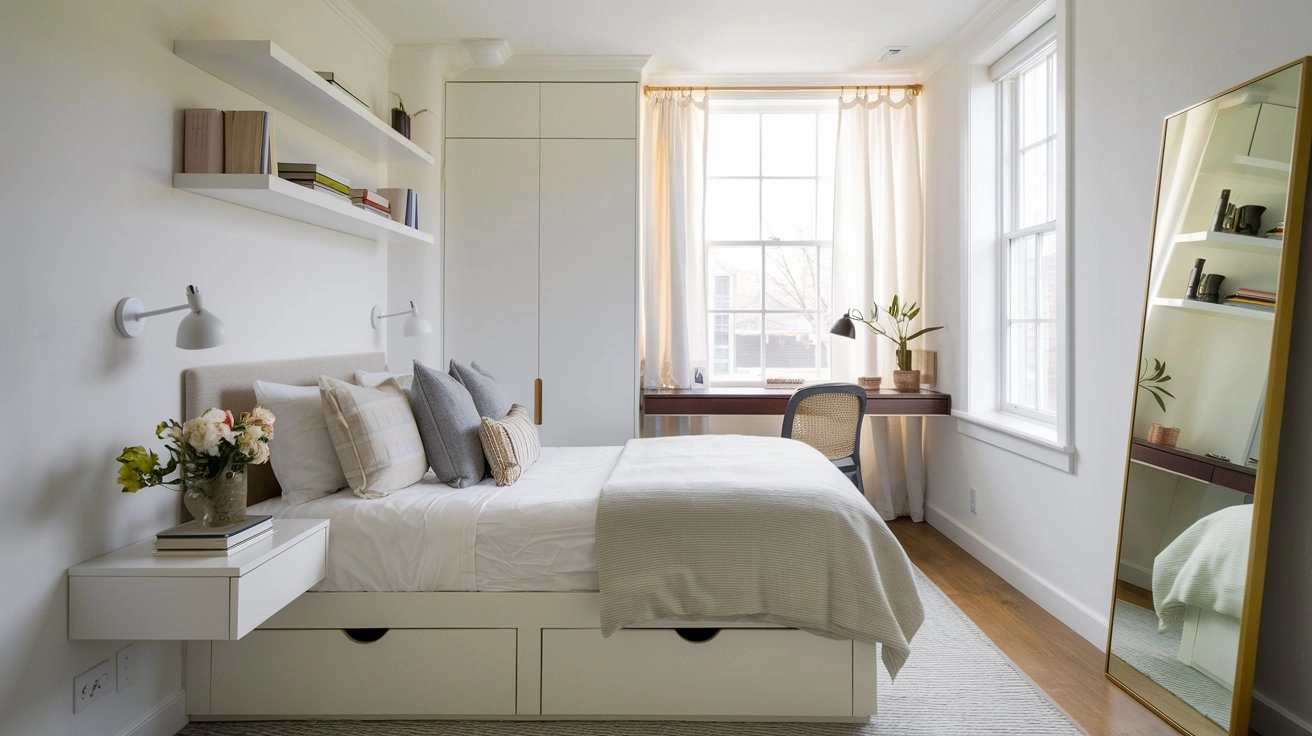
I used to hate walking into my small bedroom. The layout felt all wrong. Furniture was in the way, storage was a mess, and I always felt cramped in what was supposed to be my relaxing space.
It drove me crazy every single day. But once I figured out how to set up a small bedroom correctly, everything changed. Now, I’m all about making the most of every little inch.
If you’re looking for Small Bedroom Layout Ideas, you’re in the right place.
In this guide, I’ll show you my favorite layout tips, clever storage ideas, and simple design tricks. You’ll see how easy it is to turn your bedroom into a cozy, organized space you enjoy being in.
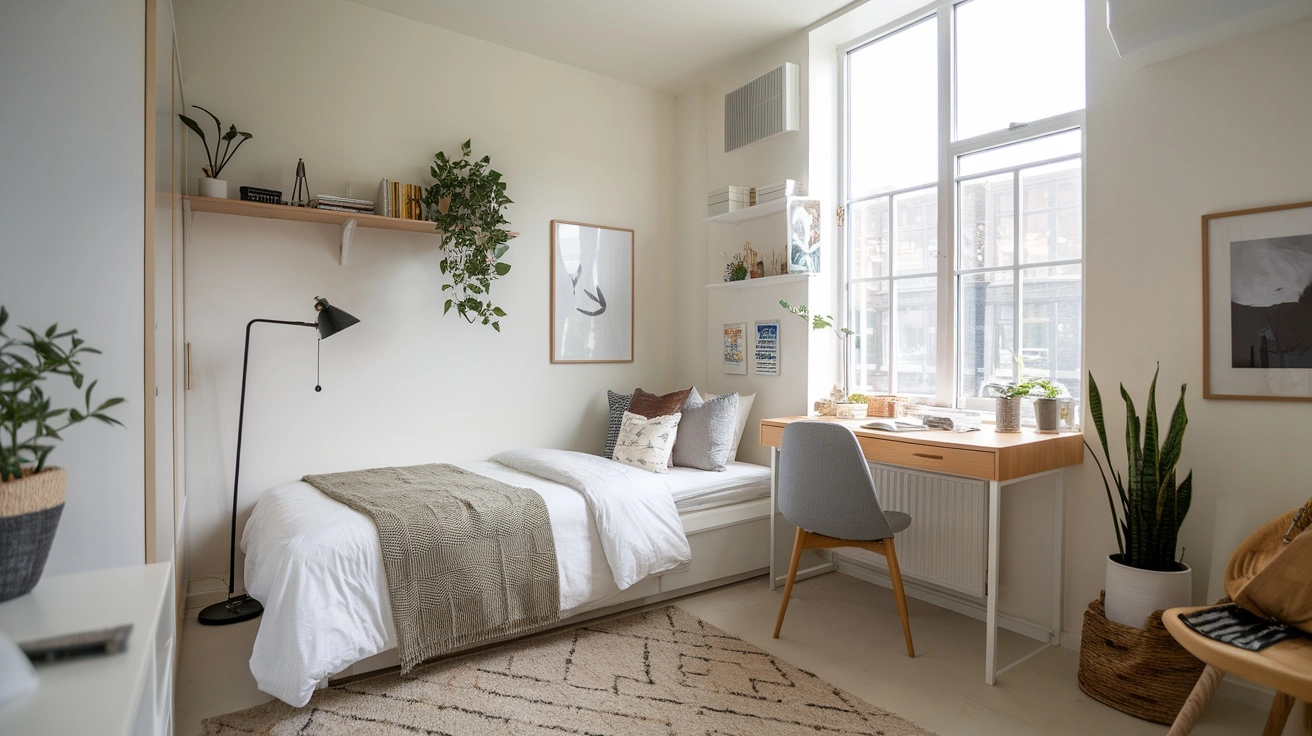
Why Your Small Bedroom Layout Is Your Secret Weapon
Thoughtful small bedroom layouts have truly transformed my relationship with my space.
Instead of feeling confined and frustrated, I now have a bedroom that feels spacious and serene.
You’ll love how proper furniture placement eliminates that cramped feeling and creates a room that feels twice its actual size.
The beauty of optimizing your small bedroom layout is that it front-loads all the planning work. I spend time thinking about the flow of the room, measuring carefully, and considering how I utilize the space on a daily basis.
This preparation allows me to enjoy a functional and comfortable bedroom that meets all my needs, despite its limited square footage.
Beyond saving space, a well-designed small bedroom layout ensures that you consistently get both functionality and style in your most personal space. I’ve found that having a thoughtfully arranged bedroom means I’m much more likely to keep it organized and peaceful, even when life gets hectic.
Essential Tools for Effective Small Bedroom Planning
Before diving into the layout process, let’s discuss the tools that make planning for a small bedroom easier. I’ve tested countless methods, and these are the essentials that work for maximizing your limited space.
Measuring Tools
I always keep a measuring tape, graph paper, and a ruler handy. Trust me, accurate measurements are the foundation of any successful small bedroom layout. Measure everything twice before making any furniture decisions.
Layout Apps
A good room planner app makes all the difference when working with limited space. You don’t need the most expensive option, but look for one that allows you to input exact room dimensions and experiment with furniture placement.
Furniture Templates
I always create scaled templates of my furniture pieces on paper or cardboard. This allows me to physically move pieces around on my floor plan without breaking my back rearranging actual furniture repeatedly.
3 Foolproof Small Bedroom Layout Methods
I’ve experimented with numerous approaches to small bedroom layouts over the years, and these three methods consistently deliver the best results. Each has its advantages depending on your room shape, furniture needs, and personal preferences.
Method 1: The Wall-Hugging Layout
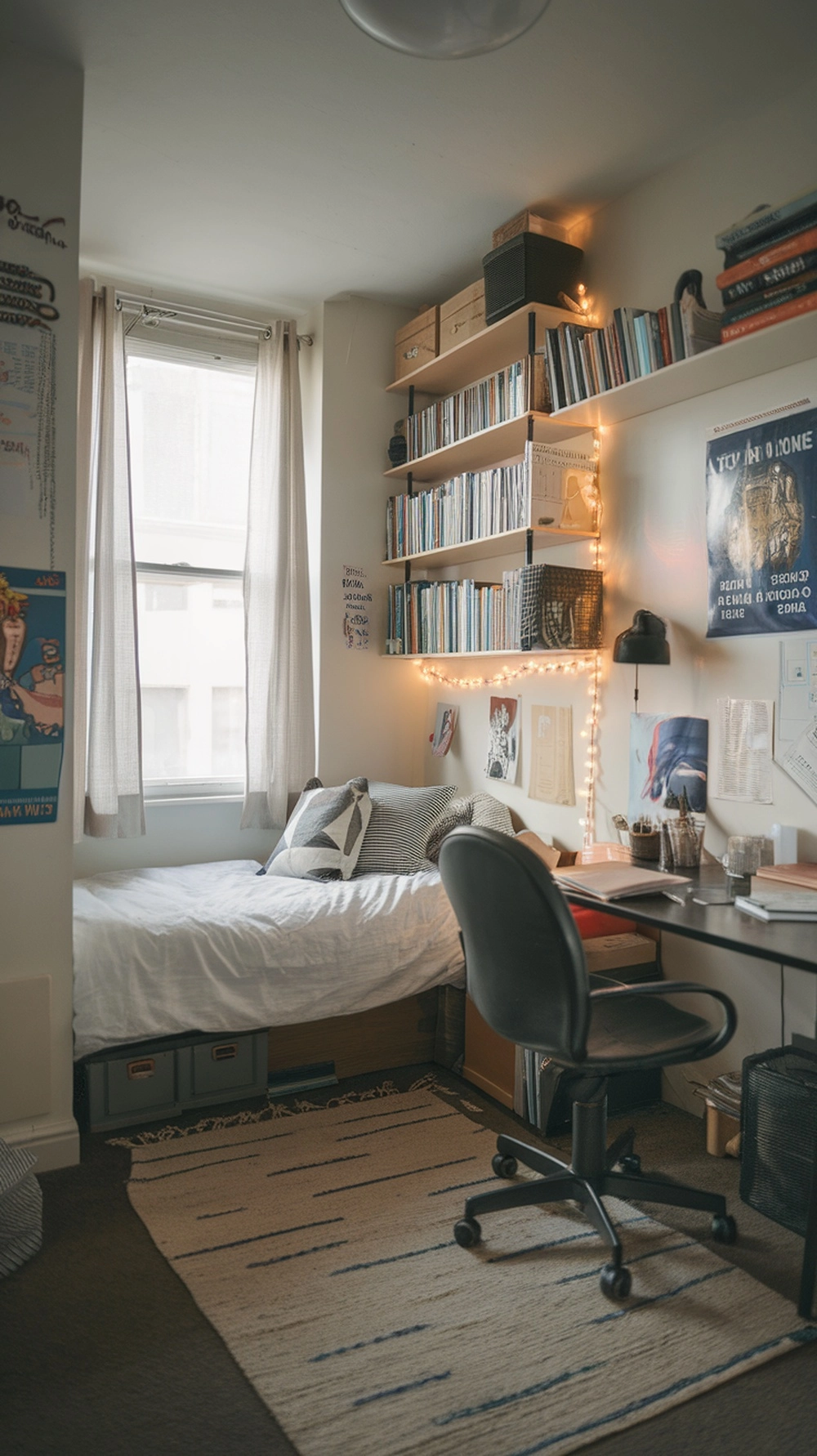
- Position your bed against the wall: I find that placing the bed with the long side against the wall opens up valuable floor space. This works exceptionally well in tiny bedrooms where every inch counts.
- Use vertical space: Install floating shelves and wall-mounted lighting to free up floor and surface area. I typically mount shelves at least 12 inches above the bed or desk.
- Minimize furniture footprints by selecting pieces with legs rather than solid bases, which creates a sense of openness. I prefer nightstands and desks that don’t feel visually heavy.
- Create clear pathways: Ensure there is at least 24 inches of walking space around all necessary pathways. This prevents the room from feeling cramped.
- Utilize door space: Add hooks or over-door organizers to maximize storage without consuming floor space.
When implementing this layout, focus on keeping the center of the room as open as possible. This method is my favorite for tiny bedrooms because it creates the illusion of more space while maintaining functionality.
Method 2: The Diagonal Approach
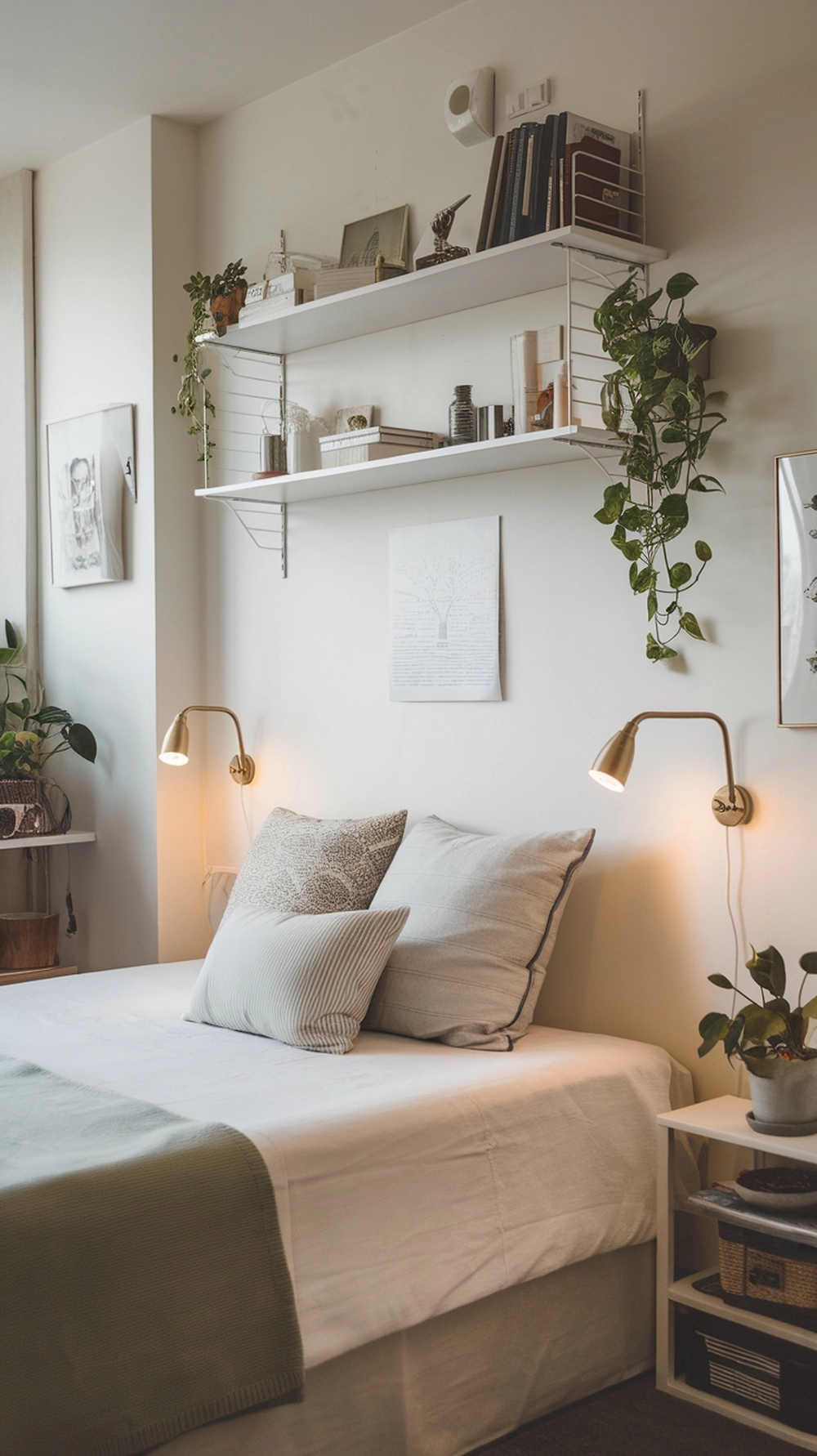
- Position your bed at an angle: Place the bed diagonally in a corner to create visual interest and potentially more usable space around it.
- Use corner furniture: Incorporate corner desks or shelving units that fit perfectly into otherwise wasted space.
- Create zones: Divide the room into sleeping, storage, and activity areas for better organization.
- Consider traffic flow: Ensure the diagonal placement doesn’t obstruct movement through the room.
I love this method when working with awkwardly shaped rooms or when I want to create visual interest. The diagonal placement can make a small bedroom feel more dynamic and less boxy.
Method 3: The Multifunctional Approach
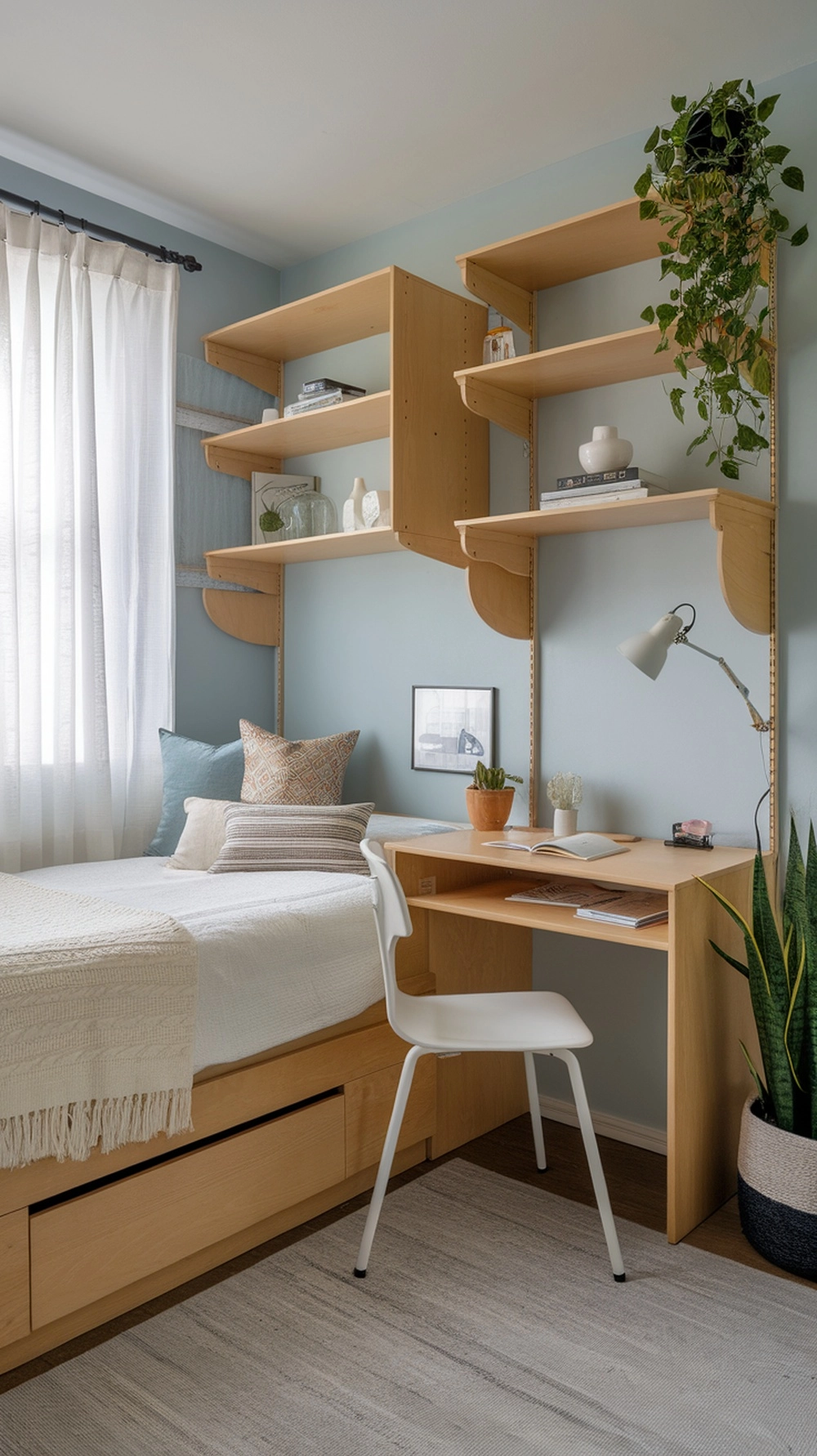
- Choose dual-purpose furniture: Invest in a bed with storage drawers, a desk that doubles as a nightstand, or a bench that offers seating and storage.
- Implement vertical solutions: Use tall, narrow dressers and bookcases that maximize storage while minimizing footprint.
- Consider Murphy beds or daybeds: These options free up floor space when the bed isn’t in use.
- Utilize modular furniture: Pieces that can be reconfigured according to your needs provide flexibility in small spaces.
- Incorporate hidden storage: Look for ottomans, headboards, and other pieces with concealed storage compartments.
This approach is my go-to when I need my small bedroom to serve multiple functions, such as a bedroom and home office or a guest room. The key is selecting furniture that works twice as hard so you can do more in less space.
What to Include vs. What to Skip: Small Bedroom Furniture Guide
Essential Pieces
- Space-saving bed: Platform beds, storage beds, or wall beds
- Slim nightstand: Floating shelves, narrow tables, or wall-mounted options
- Vertical storage: Tall, narrow dressers or bookcases
- Multi-purpose items: Desk/vanity combos, storage ottomans, fold-down tables
- Wall-mounted lighting: Sconces or pendant lights to free up surface space
Items to Reconsider
- Bulky furniture: Oversized beds, wide dressers, large armchairs
- Single-purpose items: Decorative pieces with no storage or function
- Floor lamps: They consume valuable floor space
- Extra seating: Unless necessary or multifunctional
- Oversized artwork: Can make the room feel smaller (opt for a gallery wall instead)
Pro Tip: I’ve found that choosing a bed frame with visible space underneath creates the illusion of more floor area, even if you use under-bed storage containers. This visual trick makes a small bedroom feel less cramped than one with a bed that sits flush against the floor.
Step-by-Step Small Bedroom Layout Process
I’ve refined my small bedroom layout routine to be as efficient as possible. Here’s my exact process for transforming a cramped bedroom into a functional, stylish space:
- Measure everything: Take precise measurements of your room, including doors, windows, and any architectural features. I always create a to-scale drawing on graph paper.
- Assess your needs: Determine what activities must happen in your bedroom beyond sleeping. Do you need a workspace? Extra storage? Reading nook?
- Inventory your furniture: Measure all pieces you plan to keep and create scaled templates. Be ruthless about what stays and what goes.
- Plan traffic flow: Identify the paths you need to walk through the room and ensure they remain clear (at least 24-30 inches wide).
- Position your bed first: As the most significant piece, your bed placement determines everything else. Consider all three methods I outlined earlier.
- Arrange the remaining furniture: Work from the largest to the smallest pieces, ensuring proper clearance around each item.
- Test your layout: If possible, physically arrange your room according to your plan and live with it for a few days before making final decisions.
The Perfect Small Bedroom Layout Formula: Mix and Match Guide
Creating balanced small bedroom layouts becomes effortless once you understand the basic formula. I use this framework for all my bedroom planning projects:
| Zone | Purpose | Key Elements | Space-Saving Tips |
| Sleep Zone | Primary sleeping area | Bed, nightstand, reading light | Movement through the room |
| Storage Zone | Clothing and personal items | Dresser, closet, hooks | Vertical dressers, closet organizers, over-door storage |
| Function Zone | Work, vanity, or hobby area | Desk, chair, task lighting | Wall-mounted desk, folding chair, dual-purpose furniture |
| Pathway Zone | Movement through room | Clear walking paths | Minimum 24″ clearance, furniture with visible legs |
| Accent Zone | Personalization and style | Art, mirrors, plants, textiles | Wall-mounted decor, mirrors to expand space, vertical arrangements |
I love how this formula makes it easy to create a functional layout while ensuring each small bedroom is personalized to the individual’s needs. When planning your space, prioritize the zones that matter most to you while minimizing or combining others.
Troubleshooting Common Small Bedroom Layout Challenges
Even with the best planning, you might encounter a few challenges when arranging your small bedroom. Here are solutions to the most common issues I’ve faced:
Awkward Room Shapes
- Sloped ceilings: Place the bed where the ceiling height is most significant; use lower areas for storage or seating.
- L-shaped rooms: Divide into distinct zones based on the natural architecture.
- Narrow rooms: Position the bed on the short wall to maximize floor space.
Structural Limitations
- Multiple doors and windows: Draw them on your floor plan first and work around them.
- Radiators/vents: Ensure furniture doesn’t block airflow; use radiator covers as shelves.
- Low ceilings: Opt for lower-profile furniture and utilize vertical stripes to create the illusion of height.
I learned the hard way that not all furniture fits through doorways! Before purchasing any large pieces for your small bedroom, measure your doorways, hallways, and any tight corners the furniture will need to navigate during delivery or assembly.
Small Bedroom Organization Systems That Work
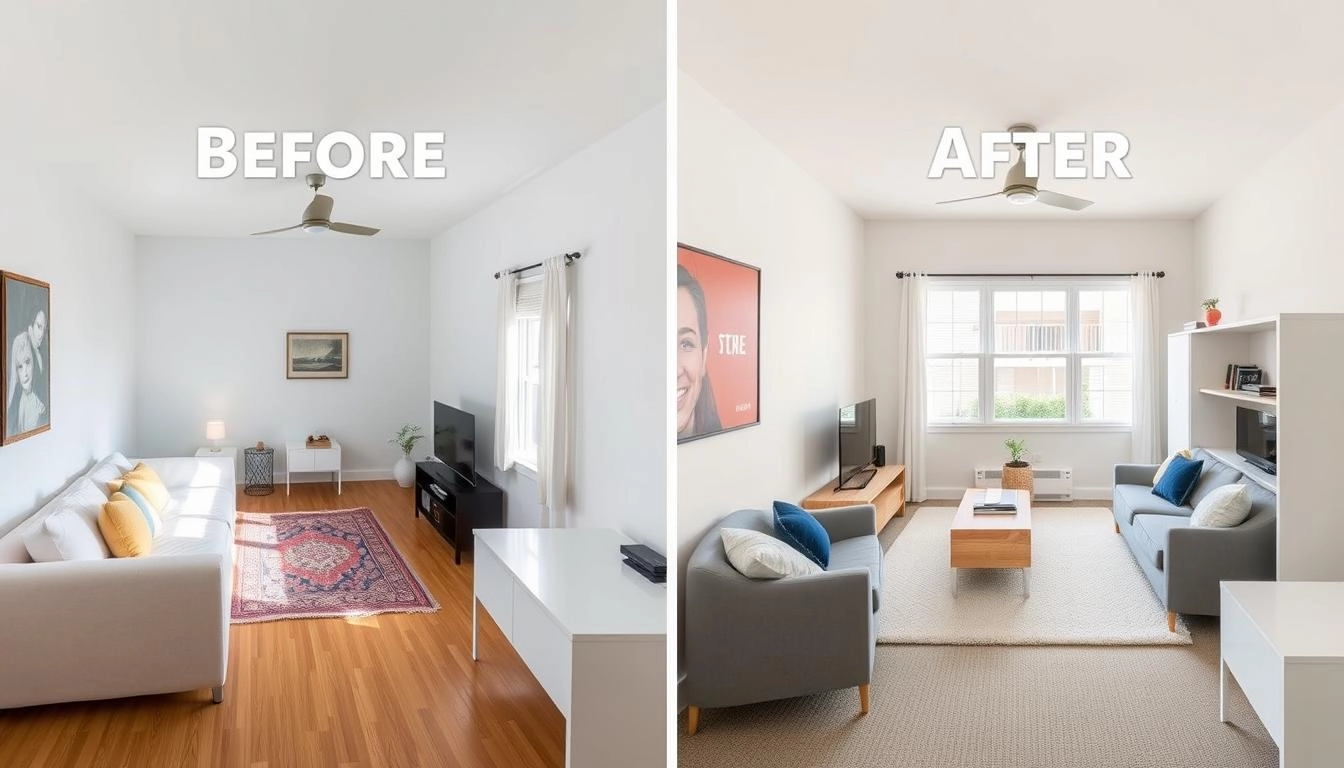
Keeping your small bedroom organized is crucial to maintaining a sustainable layout. I’ve tried many approaches and found these organization methods to be the most effective in a limited space:
Vertical Storage Solutions
- Floor-to-ceiling shelving: I love using tall, narrow bookcases that maximize storage while minimizing footprint.
- Wall-mounted organizers: Install modular systems that can be customized to your specific needs.
- Over-door solutions, such as hooks, racks, and hanging organizers, utilize often-forgotten space.
Hidden Storage Ideas
- Under-bed containers: Choose shallow, wheeled options for easy access to seasonal items.
- Furniture with storage: Ottomans, benches, and headboards with hidden compartments pull double duty.
- Behind-door storage: Slim rolling carts can fit in narrow spaces between furniture and walls.
Small Bedroom Layout Guidelines: For optimal flow, maintain at least 24 inches of walking space around the bed, 36 inches in front of dressers and closets for drawer and door clearance, and a minimum of 20 inches around a desk chair when in use.
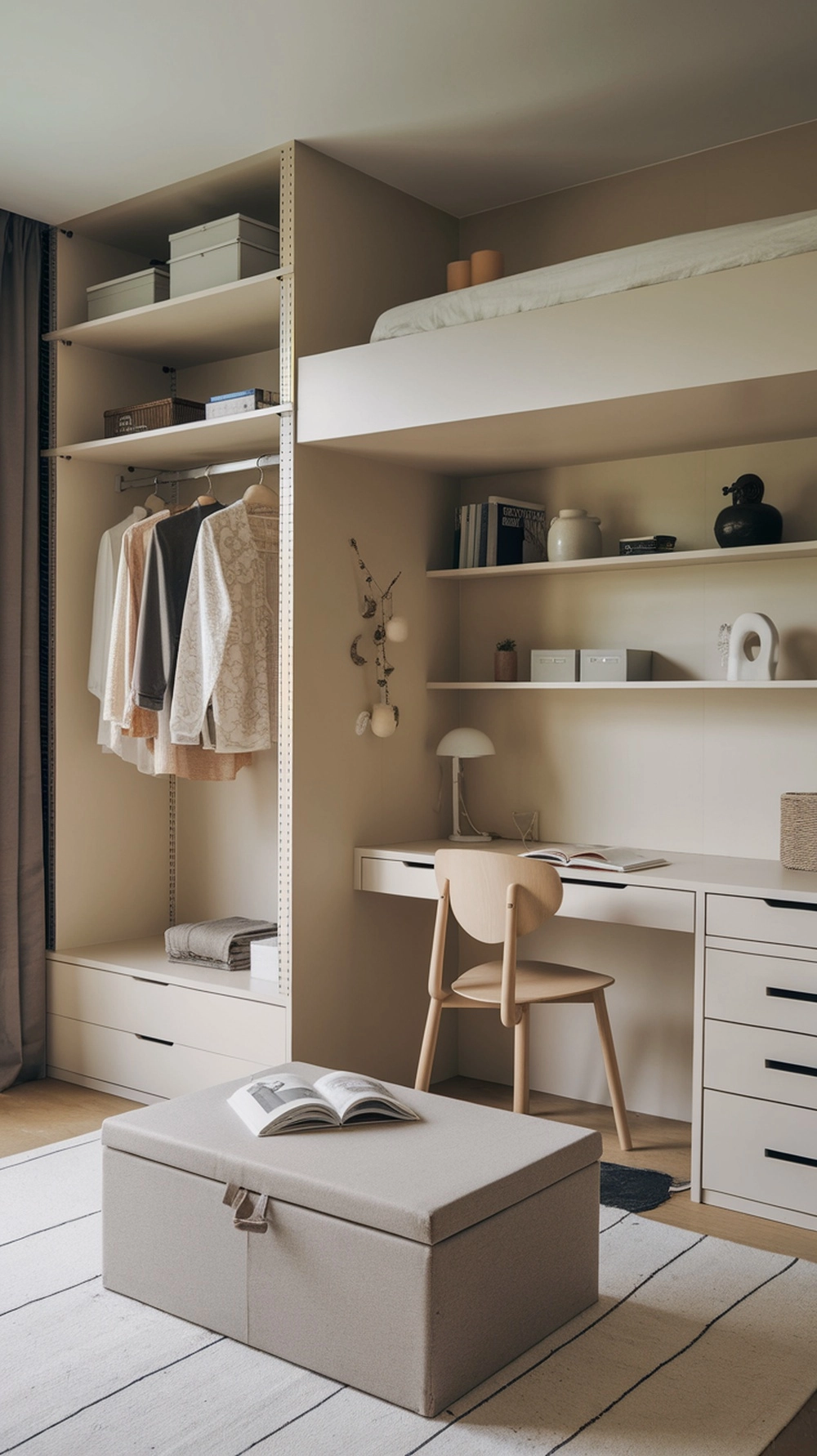
8 Design Tricks That Make Small Bedrooms Feel Larger
Beyond furniture placement, these design strategies can dramatically impact how spacious your small bedroom feels:
Strategic Mirrors
I always incorporate at least one large mirror in small bedrooms. Position mirrors to reflect light sources or windows, effectively doubling the perceived space and brightness.
Monochromatic Color Scheme
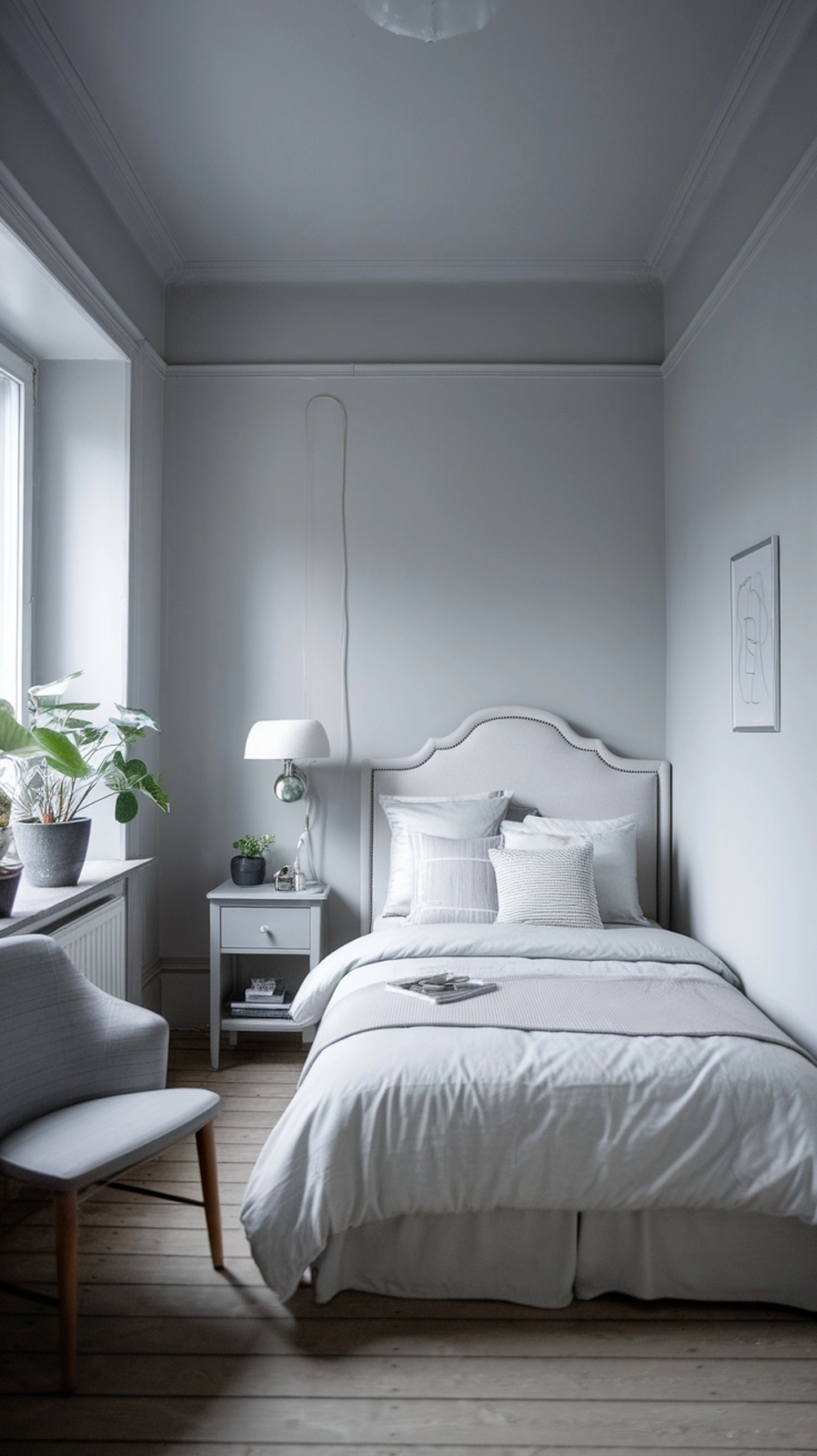
Using variations of the same color throughout a small bedroom creates visual continuity that expands the space. I prefer light neutrals for maximum brightness, but any cohesive palette works.
Visual Weight Distribution
I carefully distribute visual weight throughout the room, balancing heavier pieces with lighter elements. Furniture with visible legs creates a sense of openness by showing more of the floor.
Ceiling Treatments
Drawing the eye upward with ceiling treatments creates the illusion of height. I love using subtle patterns or paint that complements the wall color but adds dimension.
Scaled Furniture
Choosing furniture proportional to your room size prevents the cramped feeling that comes from oversized pieces. I look for slimmer profiles and suitable heights to create a harmonious scale.
Strategic Lighting
I always incorporate at least three light sources at different heights in small bedrooms. This layered approach eliminates dark corners and creates depth, expanding the perceived space.
Decluttered Surfaces
Keeping surfaces 75% clear creates visual breathing room, which is crucial in small spaces. I limit decorative items to a few meaningful pieces and maintain a rigorous level of organization.
Vertical Lines
Incorporating vertical lines through tall, narrow furniture, floor-to-ceiling curtains, or striped wallpaper creates the illusion of height. I use this trick in rooms with low ceilings.
Small Bedroom Layouts for Specific Needs
Different needs require tailored approaches to small bedroom layouts. Here are my recommendations for common scenarios:
Small Bedroom with Queen Bed
- Center the bed on the longest wall to create balance and maximize walking space on both sides.
- Use slim nightstands: Look for options under 12 inches deep to preserve precious floor space.
- Skip the footboard: Opt for a simple headboard-only design to minimize visual bulk.
- Utilize vertical storage: With floor space at a premium, consider utilizing vertical storage solutions.
Small Bedroom Home Office Combo
- Create distinct zones: Visually separate the sleeping and working areas with area rugs or furniture placement.
- Consider a Murphy desk: Wall-mounted fold-down desks disappear when not in use.
- Use a desk as a nightstand: Position a small desk next to the bed to serve as a dual-purpose nightstand.
- Implement good task lighting: Ensure proper illumination for work without disturbing the restful atmosphere.
Small Guest Bedroom
- Choose flexible sleeping options, such as daybeds, Murphy beds, or high-quality sofa beds, to maximize everyday usability.
- Provide accessible storage: Offer empty drawers and hanging space for guests’ belongings.
- Include thoughtful amenities: A small desk or table, reading light, and charging station enhance guest comfort.
- Consider multi-purpose use: Design the room to function as an office, reading room, or hobby space when not hosting guests.
Transform Your Space with Smart Small Bedroom Layout Ideas
I’ve seen firsthand how thoughtful small bedroom layout ideas can transform cramped quarters into stylish, functional sanctuaries.
By spending time planning your furniture placement, incorporating clever storage solutions, and implementing visual tricks, you’ll create a bedroom that feels spacious despite its limited square footage.
Remember that the perfect small bedroom layout is the one that works for you. Experiment with the different methods I’ve shared, find your favorite space-saving furniture pieces, and adapt the process to fit your lifestyle and preferences.
Whether you opt for the wall-hugging approach, diagonal placement, or a multifunctional strategy, the key is thoughtful planning.
I’d love to hear which small bedroom layout works best for you! And don’t forget to download my free bedroom planning guide for even more tips, templates, and organization ideas to make your small bedroom transformation even easier.
